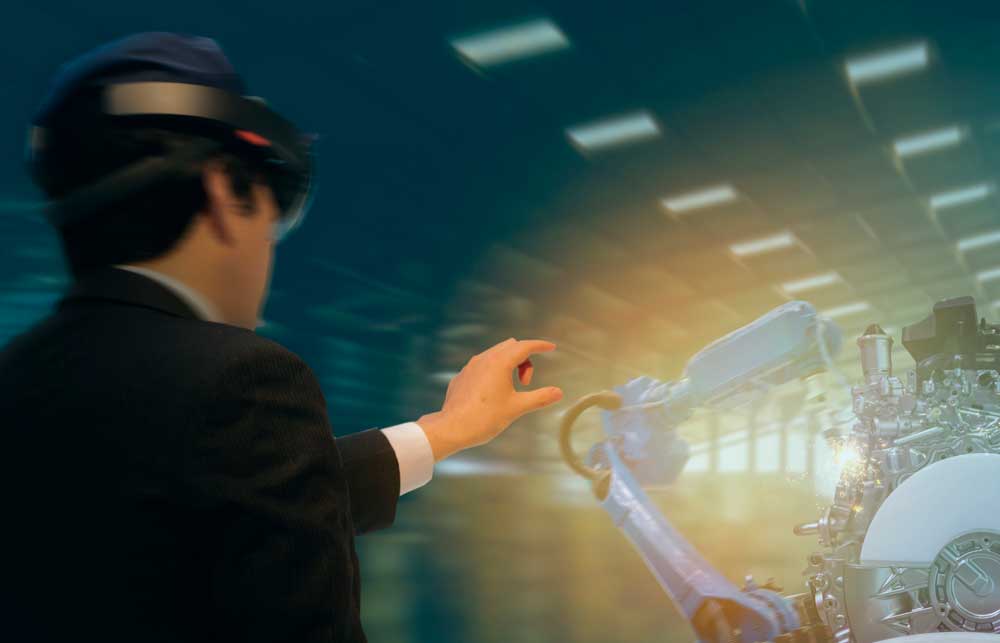Artificial Intelligence needs an expert partner
Artificial intelligence (AI) is well-suited for various applications in maintenance, if development considers application-specific requirements and limitations. Reliable models and expertise don't need to be reinvented through AI; instead, AI can be applied selectively. The importance of staff training is increasing.
AI aims to use computational heuristics that simulate human intelligence. Generative AI assists in laying the groundwork by investigating past solutions and development ideas. This topic has been discussed in previous parts of this article series in Promaint magazine issues 2 and 3/2024.
Partial solutions developed using narrow AI for utilizing datasets create insights into the usefulness of AI in organizational business and technological environments. Flexible AI applications tailored to different targets provide increasing benefits through a better cost-benefit ratio. However, many elements typically required for solutions are not feasible to achieve solely with AI. In such cases, hybrid solutions, combining AI with components developed using other methods, are necessary.
Narrow AI brings tools for effective data utilization
The broader use of data requires the adoption of new methods, which demand technological readiness and trust in the quality and efficiency of these methods. While many building blocks for developing AI solutions already exist, their effective use requires training and engagement, enabling individuals to use AI as a tool to enhance their work rather than replace it.
The quality of the required data has slowed down the adoption of these methods and computing capabilities. Solutions within computational intelligence methods can also operate with less-than-perfect data. AI can also drive improvements in data quality and encourage more accurate record-keeping by giving data a clear purpose.
Progressing through hybrid solutions in maintenance
When AI is incorporated into decision-making, comprehensibility becomes a central requirement. Solutions brought by deep learning can often be too complex to replicate consistently. Despite their appeal, incorporating decision-making into deep learning easily becomes too unreliable. Instead of mere black-box solutions, hybrid approaches that use fuzzy logic can interpret AI operations. This is particularly effective in multi-objective optimization when operational conditions have a significant impact.
In maintenance, AI can leverage data collected from maintenance systems as well as as-close-to-real-time-as-possible information from condition monitoring. This is especially important at the device level. Expertise can be analyzed using generative AI, particularly in lifecycle management and during the procurement phase of production assets. Both paths converge at the operational level of production units. The need for training also varies depending on whether it’s condition monitoring, maintenance, or production asset management.
Condition monitoring:
Condition-based maintenance requires indicators based on signal processing and data analysis. AI can expand the range of indicators, but a more critical role is combining indicator data into new indicators and using their overall structure in diagnostics. There are similarities between similar machines and devices, but individual differences become apparent at least through operational history. General solutions may not achieve sufficient accuracy. Results can be improved by identifying similarities in machine-specific models, and recursive updates conducted periodically can further enhance equipment functionality.
Device-level operations:
The aim of AI at the device level is to produce increasingly refined maintenance thresholds. This can extend the intervals between scheduled and condition-based maintenance tasks, which in turn improves availability and/or reliability. The maintenance time saved can be used to improve the efficiency of the procedures themselves, reduce delays, and shorten active maintenance periods. Conversely, lengthening intervals between procedures may also enable the timely delivery of spare parts, which is crucial as delivery times increasingly lengthen.
Production unit/department-level operations:
In many technological environments, maintenance activities need to be packaged optimally, considering the criticality of individual devices and maintenance requirements. Such environments include continuous flow production structures with high availability demands.
AI can assist maintenance and production in optimizing downtime scheduling and selecting tasks to be included. An optimal timing may reduce breakdowns and other negative business impacts, potentially extending the interval between downtimes. AI algorithms can also be likely to enhance the efficiency of maintenance shutdowns. Realizing the benefits of optimal task packaging naturally depends on the business and technological environment in which maintenance operates. Initially, the use of AI requires substantial verification and validation, which increases the workload of experts at various levels.
Lifecycle management:
AI plays a role in producing data for examining requirements set by economic and business goals and strategies. This involves evaluating the economic and other business impacts of different operational alternatives, as well as optimal shutdown times and work plans.
Hybrid solutions are needed to address uncertainty when exploring the connection between shutdown scheduling and operational alternatives with cash flow calculations and the business and strategic impacts of actions. When comparing the optimal timing of replacement, improvement, and modification investments, hybrid solutions are required to manage technical, economic, and logistical uncertainties, focusing on the organization’s strategic goals.
Acquisition phase of physical/production assets:
The first definitions of production asset management, including maintenance, are currently made during the design phase. AI is expected to offer new tools to support both these definitions and the design of operational reliability. Digital twins and simulation tools based on them, as well as less demanding technical system models, aid in executing complex design tasks.
The requirements for AI are especially important during the design phase. At this stage, connections to business objectives, strategies, and accounting are particularly demanding due to greater uncertainty compared to the operational phase. These models are also useful tools during the plant commissioning and operational phases, with their quality improving as information accumulates with increasing operational hours.
Asset acquisition, as well as the procurement of individual devices, is expected to become more efficient, although continually growing requirements may work in the opposite direction. The technical documentation and work instructions provided by equipment suppliers are expected to improve, enhancing the quality and efficiency of AI use.
Organizational considerations:
AI development and implementation free personnel for development tasks, but applying AI requires understanding the methods involved. Training is needed to address uncertainty in planning and decision-making, as well as to grasp the principles, strengths, and challenges of multivariate methods.
Defining AI tools suitable for one’s application environment and ensuring high-quality, timely, and appropriately formatted data storage requires leveraging both documented and tacit knowledge of the entire technical staff.
Developing AI tools themselves requires not only expertise in various methods and influencing factors but also consideration of organizational-specific requirements and characteristics. For this reason, the demand for these services is expected to grow, but organizations themselves must understand maintenance requirements within the framework of asset management from a new perspective.
Organizational expertise remains central. AI does not replace this expertise but rather becomes a tool for analyzing situations, much like information technology did earlier. Over time, operations become more efficient, and quality improves. At the same time, expertise is enhanced. No fundamental leap or new mode is required. There will be impacts on work distribution and the use of external services, clarifying former practices.
The role of technology providers:
In terms of the technologies used by organizations, the role of technology providers (equipment manufacturers) or service providers with in-depth expertise in specific technological products will strengthen both in lifecycle management and maintenance. The role of the entire plant designer is also expected to strengthen, as AI use during the procurement phase is anticipated to increase. Conversely, organizations’ desire to avoid dependency on a single provider serves as a counterbalance.
Organizational impacts will also significantly depend on the specific organizational and technological environments; for instance, paper and steel mills require a different operating model than machine shops or shipyards.
Integrating AI in control and maintenance
Condition-based maintenance aims to predict maintenance thresholds and the need for shutdowns. Rather than predicting failure time, improvements or at least delays in deteriorating conditions can be achieved by incorporating the condition and stress of process equipment and machines into control. This simultaneously reduces the risk of unexpected damage.
Stabilizing control:
Continuous condition monitoring provides useful indicators and intelligent analyzers to support control. Through control execution, additional information is simultaneously obtained for condition monitoring. The goal here is continuous operation.
Optimizing and coordinating control:
Continuous condition monitoring could also play a central role in continuously compiling symptoms of failure for adaptation to changing conditions. Periodic condition monitoring leads to diagnostic and prognostic-based optimized and coordinated control. This involves periodic operational changes.
Adapting control strategy:
Condition monitoring and performance tracking are needed to adapt control strategies through diagnostics and prognostics, potentially involving short-term scheduling as well.
Real-time and updated information is required at all levels for decision-making. Integrating control and condition monitoring solutions aims to enable wise operations in changing conditions.
Challenges in applying AI
There are plenty of use cases, but many requirements and limitations must be addressed:
• Data quality and availability limit application development and potential use cases. Assembling all the necessary data in a balanced manner is difficult.
• Integration of AI solutions with condition monitoring systems requires careful validation. In practice, condition monitoring solutions must be assembled from components.
• Comprehensibility of AI solutions is essential for integration.
• Lack of reproducibility in computation also does not inspire confidence.
• Efforts towards standardization are present in all systems, but in the AI field, this is still far off due to insufficient validation and testing.
• Data management faces numerous challenges in maintaining extensive and multifaceted data in a balanced manner under changing conditions.
AI is well-suited for many applications in maintenance when application-specific requirements and limitations are factored into development. Data analysis is a valuable addition.
It’s also important to remember that reliable models and expertise do not need to be reinvented with AI: AI is applied selectively. The importance of expertise necessitates skilled personnel for various applications. The need for training does not diminish.
AI has developed over a long period
The key utilization of AI is based on the long development history of intelligent solutions. Since the 1950s, the model of brain structure has served as the basis for neuromorphic computing, where calculations occur in interconnected layers.
Photos: SHUTTERSTOCK












